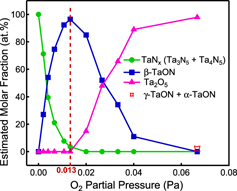Crossref Citations
This article has been cited by the following publications. This list is generated based on data provided by
Crossref.
Lin, Der-Hwa
and
Chang, Kao-Shuo
2016.
Photocatalytic and photoelectrochemical performance of Ta3N5 microcolumn films fabricated using facile reactive sputtering.
Journal of Applied Physics,
Vol. 120,
Issue. 7,
Reinhardt, Anna
Frenzel, Heiko
von Wenckstern, Holger
Spemann, Daniel
and
Grundmann, Marius
2016.
Electron transport mechanism in rf‐sputtered amorphous zinc oxynitride thin films.
physica status solidi (a),
Vol. 213,
Issue. 7,
p.
1767.
Suram, Santosh K.
Fackler, Sean W.
Zhou, Lan
N’Diaye, Alpha T.
Drisdell, Walter S.
Yano, Junko
and
Gregoire, John M.
2018.
Combinatorial Discovery of Lanthanum–Tantalum Oxynitride Solar Light Absorbers with Dilute Nitrogen for Solar Fuel Applications.
ACS Combinatorial Science,
Vol. 20,
Issue. 1,
p.
26.
Gregoire, John M.
Boyd, David A.
Guevarra, Dan
Haber, Joel A.
Jones, Ryan
Kan, Kevin
Marcin, Martin
Newhouse, Paul F.
Shinde, Aniketa
Soedarmadji, Edwin
Suram, Santosh K.
and
Zhou, Lan
2018.
Integrated Solar Fuel Generators.
p.
305.
Soedarmadji, Edwin
Stein, Helge S.
Suram, Santosh K.
Guevarra, Dan
and
Gregoire, John M.
2019.
Tracking materials science data lineage to manage millions of materials experiments and analyses.
npj Computational Materials,
Vol. 5,
Issue. 1,
Salamon, K
Mičetić, M
Sancho-Parramon, J
Bogdanović Radović, I
Siketić, Z
Šarić, I
Petravić, M
and
Bernstorff, S
2019.
$ \newcommand{\bt}{\beta} \bt$ -TaON thin films: production by reactive magnetron sputtering and the question of non-stoichiometry.
Journal of Physics D: Applied Physics,
Vol. 52,
Issue. 30,
p.
305304.
Brown, Joshua J.
Ke, Zhuofeng
Ma, Tianyi
and
Page, Alister J.
2020.
Defect Engineering for Photocatalysis: From Ternary to Perovskite Oxynitrides.
ChemNanoMat,
Vol. 6,
Issue. 5,
p.
708.
Umehara, Mitsutaro
Zhou, Lan
Haber, Joel A.
Guevarra, Dan
Kan, Kevin
Newhouse, Paul F.
and
Gregoire, John M.
2020.
Combinatorial Synthesis of Oxysulfides in the Lanthanum–Bismuth-Copper System.
ACS Combinatorial Science,
Vol. 22,
Issue. 6,
p.
319.
Heinselman, Karen N.
Roberts, Lacey S.
Young, James L.
and
Zakutayev, Andriy
2022.
Reduced synthesis temperatures of SrNbO2N perovskite films for photoelectrochemical fuel production.
Journal of Materials Research,
Vol. 37,
Issue. 2,
p.
424.
Zhou, Lan
Peterson, Elizabeth A.
Richter, Matthias H.
Lai, Yungchieh
Neaton, Jeffrey B.
and
Gregoire, John M.
2022.
Fe Substitutions Improve Spectral Response of Bi2WO6-Based Photoanodes.
ACS Applied Energy Materials,
Vol. 5,
Issue. 12,
p.
15333.
Statt, Michael J.
Rohr, Brian A.
Guevarra, Dan
Suram, Santosh K.
Morrell, Thomas E.
and
Gregoire, John M.
2023.
The Materials Provenance Store.
Scientific Data,
Vol. 10,
Issue. 1,
Gregoire, John M.
Zhou, Lan
and
Haber, Joel A.
2023.
Combinatorial synthesis for AI-driven materials discovery.
Nature Synthesis,
Vol. 2,
Issue. 6,
p.
493.





